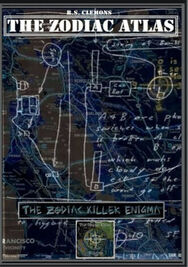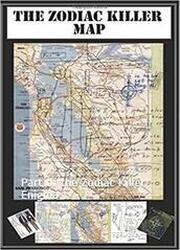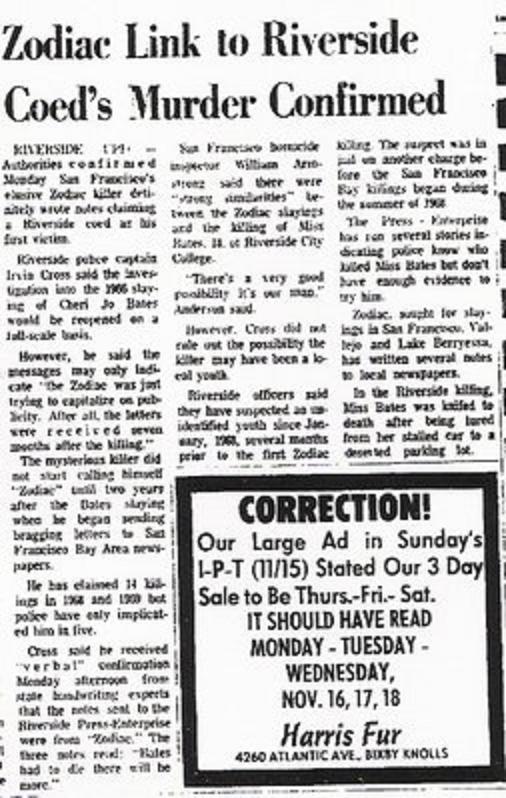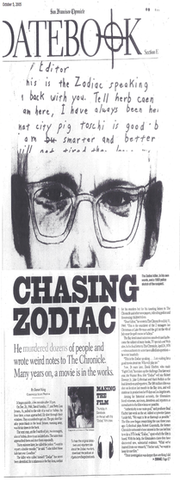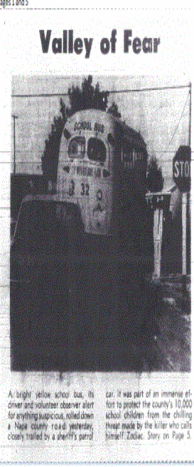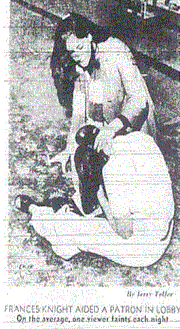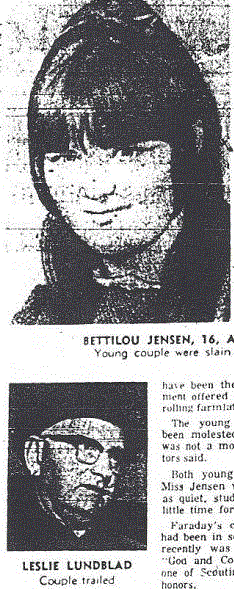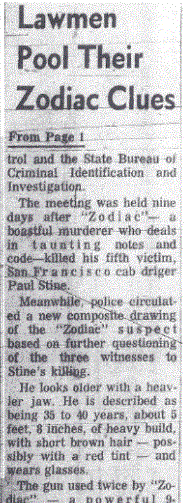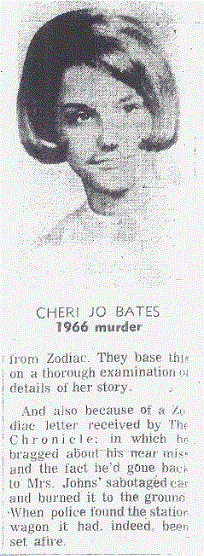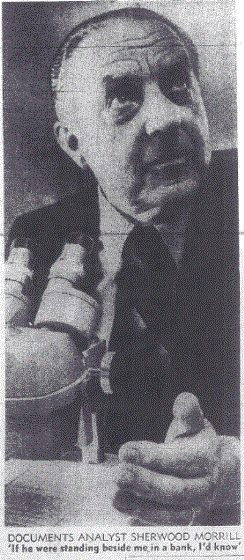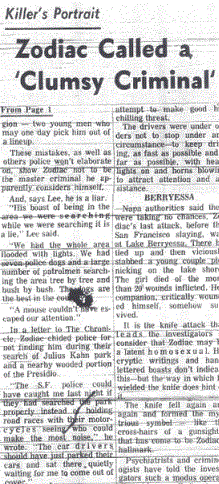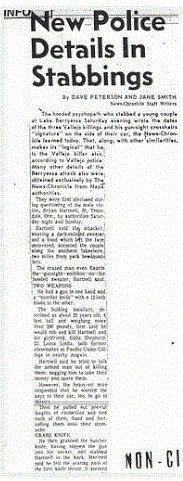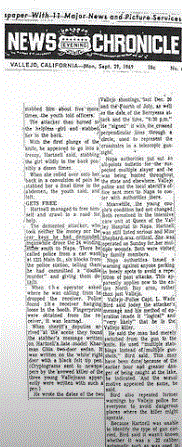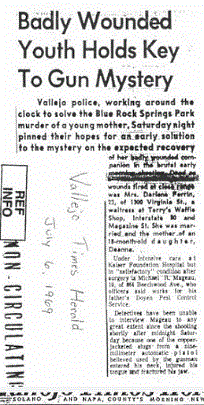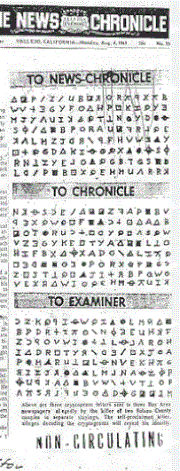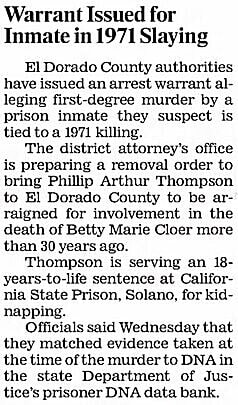
On the evening of June 18, 1971, Betty Cloer went to a dance club in Sacramento with her friends Karen Chappell and Robin Messner. Chappell was Cloer’s co-worker, and Messner and Cloer lived in the same apartment complex in Sacramento. Cloer’s roommate Elizabeth Ford stayed home alone that evening, and Messner’s younger sister babysat Cloer’s young son at Messner’s apartment. Later that evening Messner left the club with her boyfriend. Chappell and Cloer left the club around 1:00 a.m. on June 19 in Chappell’s car. Chappell stopped at a Texaco gas station on Madison Avenue in order to use the restroom. The restroom was at the back of the station near a vending machine. When Chappell pulled into the station, she saw a vehicle at the back of the station and a young man squatting near the vending machines. The man appeared to Chappell to be young, of medium height and build, with dark hair. The vehicle was a white or off-white four-door with a hard top that appeared to Chappell to be a 1963 Oldsmobile. Chappell went into the restroom and Cloer remained in the car. When Chappell came out of the restroom, she saw the man just getting into his car. The man pulled out of the gas station and Chappell followed him. At one point, the cars pulled side-by-side and Cloer rolled down her car window to speak to the man. Cloer told Chappell the guy was a “fox” and thought he was going to follow them.
When the two women arrived at Cloer’s apartment complex, the man pulled up behind them. Cloer got out and told Chappell she was going back to speak with him. As Cloer walked back toward the man’s car, Chappell drove away. Sometime between 1:00 and 2:00 a.m. Cloer went into her apartment, where Ford was sleeping on a couch in the living room. Cloer told Ford she was going to Lake Tahoe and needed a coat. Cloer left the front door open and Ford could see a man standing outside. He was approximately 6’2” to 6’4” tall. Ford did not see his face. Cloer grabbed her coat and left with the man. According to Ford, she was the only person in the apartment when the victim arrived to get a coat. Cloer then went to Messner’s apartment to tell Messner she was going to Lake Tahoe. Messner saw a tall man with dark hair with Cloer. Cloer left with the man.
Stanley Ellis provided a somewhat different version of the evening’s events. Ellis was a federal prison inmate when he learned from a 2005 newspaper report that the investigation had been reopened, and contacted detectives. Ellis testified that he was living with his wife Margaret and their children in the same apartment complex as Cloer and Messner at the time of Cloer’s disappearance. He frequently gave Cloer rides to bars and other places. He thought but was not certain that he had taken Cloer and the others to the dance club that evening, and recalled waiting in Cloer’s apartment for her to call him to come and pick them up. Also present in the apartment, according to Ellis, were Ellis’s wife and Cloer’s roommate. Ellis testified he was present when Cloer and the man arrived. According to Ellis, the man stood outside while Cloer changed her clothes. Ellis tried to engage the man in conversation and at one point even walked up to him to try and shake his hand. Ellis testified that he felt uneasy about the guy and tried to talk Cloer out of leaving with him. When Cloer and the man left, Ellis looked out a back window of the apartment and saw them get into a dark blue Lincoln. Ellis identified petitioner from a photo lineup as the man who was with Cloer. Margaret Ellis corroborated the fact that she and Stanley saw Cloer leave the apartment building with a stranger that night. Margaret Ellis could not identify the man.
Cloer’s body was discovered at approximately 1:00 p.m. the following afternoon in an isolated field approximately 15 to 20 miles west of Placerville. She was lying on her back and was nude except for a bra. Cloer had sustained three gunshot wounds, one each to the head, chest and arm. She had also suffered such crushing blows to the head that she was unrecognizable. Items of her clothing were discovered strewn about the area. There were stains on Cloer’s panties that were still moist. Officers found several .32 caliber shell casings, a .32 caliber bullet, and a set of keys. A later examination revealed a milky fluid inside the victim’s vagina, but the fluid contained no sperm. The investigating officers later received a telephone call from a woman who said her daughter, Elizabeth Ford, had a roommate who fit the description of the person found on June 19. The officers met with Ford, Messner, and Chappell. The officers also visited the Texaco station where Chappell said she had first seen the man suspected of the murder. The officers spoke with the attendants and examined credit card slips for gasoline purchases the evening of the murder. The officers made a list of the license plate numbers from the credit card slips. They later ran those numbers against Department of Motor Vehicle records to determine the registered owners. One of the credit card slips contained license plate number DUK323. However, the name on the slip was not legible. That number was registered to Thelma and Richard Hart and was associated with a 1965 Oldsmobile convertible. Although it was not known at the time, Thelma and Richard Hart were petitioner’s mother and stepfather. The officers involved in the case never investigated petitioner in connection with the murder. Sometime later, petitioner was convicted of unrelated criminal offenses, including solicitation to commit murder and being an accessory after the fact to murder, and a biological sample was obtained from him for DNA analysis and entry into the state convicted offender databank.
In July 2002, the Betty Cloer case was reopened and the bra and panties found at the murder scene were taken to the California Department of Justice crime lab for DNA analysis. Sperm cells were found on the panties, and the DNA from those cells was compared to the convicted offender database. A match was found to petitioner. Further investigation ensued, including obtaining a saliva sample from petitioner. The DNA from that sample also matched the sample from the victim’s panties. Petitioner is six feet, four and one-half inches tall. At the time of the offense, he was married to Diana Saylor. In 1971, petitioner and Saylor moved to a home on V Street in Sacramento, which was approximately six and one-half miles from the victim’s apartment.
Petitioner and a partner, Mark Masterson, operated a used car sales and service company located on Alhambra Boulevard, approximately five and one-half miles from the victim’s residence. In 2003, investigating officers located and questioned Saylor, who recalled losing some keys in 1971. When the officers showed her the keys that had been found at the murder scene, her eyes got wide and she immediately grabbed the keys and started rubbing a stone attached to the keychain. Saylor said the keychain looked familiar to her. At the trial, Saylor testified that the key ring looked familiar and was similar to one she had in 1971, but she did not positively identify it. According to Saylor, she and petitioner had been driving the Oldsmobile convertible with license plate number DUK323 in 1971. The car was a light colored, two-door convertible, with the convertible top the same color as the car body. During that period, petitioner and Saylor also owned and operated a Lincoln that was off-white in color. Saylor testified that petitioner owned guns in 1971 and often carried one in the car with him. She did not remember petitioner having a Texaco credit card.
Betty Cloer's body was discovered lying in Cameron Park, El Dorado County on June 19th 1971, located just 10 miles west of Placerville. Despite being shot in the head, chest and arm, Phillip Arthur Thompson felt the need (probably before) to inflict crushing blows to her head and face, leaving her unrecognizable. These same destructive blows to the face and head were evident in the murders of Judith Hakari and Carol Beth Hilburn. Investigators described the condition of Judith Hakari as "one of the most godawful assaults ever investigated", with her nose smashed to a pulp, several teeth knocked out, and her jaw broken in at least two places. Coroners in the murder of Carol Beth Hilburn stated that she "was so badly beaten that she was unrecognizable, suffering several skull and facial fractures, and her throat was cut". In all of the murders, the perpetrator went far beyond what was necessary to kill each woman - seemingly gaining pleasure in destroying the identity of Cloer, Hilburn and Hakari. All women were found in a state of near full or partial disrobing, with sexual degradation the overriding feature of each crime. The bodies of Betty Cloer and Judith Hakari were discovered in remote wilderness either side of Auburn, California, with just 24 miles (as the crow flies) separating each dump site. Both Hakari and Cloer were taken from their apartments (located just a few miles apart) and found 38 miles and 28 miles respectively, to the east of Sacramento - almost equidistant between South Lake Tahoe and Sacramento.
 Judith Hakari
Judith Hakari Testimony from the preliminary hearing in that case, including the victim’s testimony, was read into the record of the instant case. The jury also heard live witness testimony regarding the Sharon S.case. Mark Masterson testified that he and petitioner had both raped Sharon S. and that petitioner had persuaded another employee, John Mays, to falsely testify at the 1971 trial that both men had been with him at the auto shop on the night of the rape. Petitioner and Masterson were both acquitted in the Sharon S. case. Petitioner had been charged in the Melinda M. matter and eventually entered a negotiated plea to assault, with the sex offense charges being dropped. Melinda M. testified at petitioner’s trial that he had raped her in 1972 after he and James Allen picked her up when she was hitchhiking.
This seems extremely pertinent information when we have the testimony of a landowner on Ponderosa Way, who described three men at the gravesite where Judith Hakari would ultimately be found, acting suspiciously. He described the trunk of their vehicle open while digging into the earth. When he approached they closed the trunk and stated they were looking for bottles. A vehicle description could be extremely important with respect to vehicles owned by each of the men in the above case.
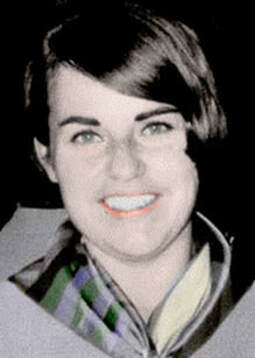 Donna Lass
Donna Lass The similarity between the Donna Lass and Judith Hakari cases, are the fact that both women had just finished their respective shifts as a nurse, either side of midnight and separated by just six months. One hopes that Donna Lass didn't receive the barbaric beatings suffered by Cloer, Hilburn and Hakari - but bearing in mind the above United States District Court transcript - it was mentioned that "Cloer told Ford she was going to Lake Tahoe and needed a coat". It is clear that Phillip Arthur Thompson was heading in that direction from Sacramento, but whether they reached South Lake Tahoe and Betty Cloer was murdered on the return journey is unclear. Whatever the case, Phillip Arthur Thompson must have mentioned Lake Tahoe to Betty Cloer - being somewhere he was undoubtedly familiar with. The question that has to be asked is, was he present near the Sahara Tahoe Hotel & Casino on September 6th 1970, with the lifeless body of Donna Lass to be found somewhere near Auburn, California? I sincerely hope this is not the case.
According to Dr. Doogie on the Zodiac Killer message board, Phillip Arthur Thompson and his wife first lived in Kings Beach, CA (on Lake Tahoe) after June 1968, but quickly moved to various locations in the Bay Area and on to Sacramento. Kings Beach sits next to Incline Village, the area featured on the infamous Pines card of March 22nd 1971, purportedly mailed by the Zodiac Killer.






 RSS Feed
RSS Feed



